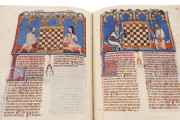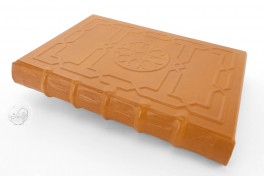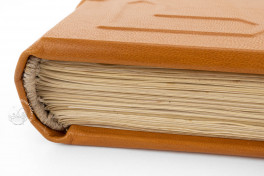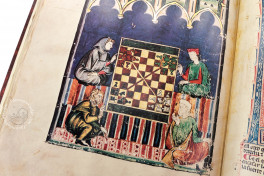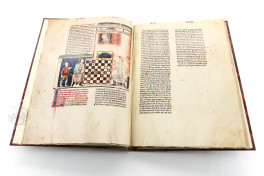The Book of Chess, Dice, and Board Games is a richly illuminated manuscript compendium of information about games of skill and chance made at the behest of Alfonso X, "the wise," King of Castile and Leon. Dated 1283, the book was made at the king's court at Seville. It is the most extensive surviving medieval compendium of chess problems and the first illuminated manuscript of chess problems to feature scenes of play rather than simple diagrams. Its 151 miniatures provide glimpses of all levels of Iberian society, from the monarch to street-dwelling ruffians.
Most of the book concerns chess problems, two-thirds of which are Spanish translations of Arabic texts. Of the original problems, half were composed by Alfonso and his courtiers. Indeed, Alfonso supervised the entire compilation, which is arranged into seven sections of diminishing size.
Blue Backgrounds
The manuscript's paintings are the work of several artists. Most miniatures appear at the top of a page and occupy about one-third of the page's text area. The miniatures are framed, many with architectural motifs, and most scenes are set before intense blue backgrounds. The figures have disproportionately large heads and hands.
Two Perspectives
Of the 103 chess problems (fols. 1-64), the first sixty-nine are presented in descending order by the number of pieces on the board. The artist presents the gaming pieces on the board as seen from above, so that the pieces and their positions are clear. The players, by contrast, are presented as the viewer might see them engaged in the game, often within an architectural setting.
Across the Social Spectrum
While those depicted playing chess and the board game of tables are usually aristocrats, the players of dice are portrayed as people of the street, poorly or barely clothed, in an implied outdoor setting (fols. 65-71). Not only players but courtiers are represented in the book's miniatures. One miniature depicts the making of gaming pieces (fol. 73r).
The range of social classes addressed in the manuscript is pictured in a miniature of Alfonso at Court (fol. 65r). The king—enthroned, crowned, and wearing a robe displaying a virtual checkerboard of the arms of Castile and Leon—dictates instructions for manufacturing gaming dice to a court scribe, while a court official presents a group of petitioners, presumably gamblers. The scene takes place in an architectural setting marked by crenelated towers. The youth at the left may be Alfonso's grandson, whom the king hoped would succeed him.
Valuable Lessons for a King
The first three sections of the book are devoted to chess (a game of skill), dice (games of chance), and tables (board games combining elements of skill and chance). There follow further games of recent invention. Alfonso considered playing games, especially games of skill, an appropriate pastime for rulers. Furthermore, he saw the devising of games as a way to develop the necessary skills for military planning and for leading a civil society.
Astronomical Knowledge at Play
Among the games in Alfonso's manuscript are board games that aid in understanding the natural order of the cosmos (fols. 81-97), and some of them require that the player apply information about the stars. Gaming strategy, therefore, needed to be applied together with book knowledge in the astronomical games, which feature polygonal boards, hexagonal dice, and multiple players (fols. 95-97).
The manuscript's text was written in two columns in Gothic Textualis. Rubrics are in red, paraph marks are in red and blue, and running titles identifying the contents of each opening are in red and blue display capitals. Pen-flourished initials introduce sub-sections of the text.
El Escorial Binding
The manuscript was kept in the royal palace at Seville until it was moved to the bed chamber of Isabella I (1451-1504), Queen of Spain, in the fifteenth century. From there, it went to the Capilla Real de Granada. Philip II (1527-1598), King of Spain, claimed it for the monastic library at El Escorial in 1591. It is today preserved in a nineteenth-century binding of parchment over pasteboard with an embossed design of a simple grill, the instrument of the martyrdom of Saint Lawrence, to whom the monastery is dedicated.
We have 2 facsimiles of the manuscript "Book of Chess, Dice, and Board Games":
- Libro de los Juegos de Ajedrez, Dados y Tablas de Alfonso X el Sabio (Parchment Facsimile) facsimile edition published by Scriptorium, 2010
- Alfonso X el Sabio - Libro de los Juegos, de Ajedrez, Dados y Tablas facsimile edition published by Vicent Garcia Editores, 1987













